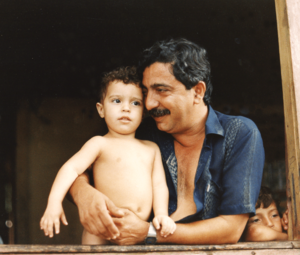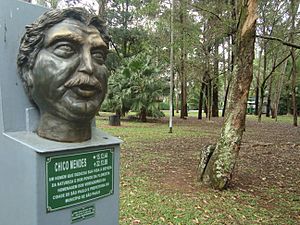Chico Mendes facts for kids
Quick facts for kids
Chico Mendes
|
|
|---|---|

Chico Mendes in 1988
|
|
| Born | 15 December 1944 Xapuri, Brazil
|
| Died | 22 December 1988 (aged 44) Xapuri, Brazil
|
| Cause of death | Murdered by Darci Alves da Silva |
| Occupation | Social activist |
| Spouse(s) | Ilsamar Mendes |
| Children | Angela Mendes Elenira Mendes Sandino Mendes |
Francisco Alves Mendes Filho, known to many as Chico Mendes (born December 15, 1944 – died December 22, 1988), was a brave Brazilian rubber tapper. He was also a strong union leader and an environmentalist. Chico Mendes worked hard to protect the amazing Amazon rainforest. He also fought for the human rights of farmers and Indigenous peoples in Brazil. Sadly, he was killed by a rancher in 1988. Today, an important group called the Chico Mendes Institute for Biodiversity Conservation is named after him. This group helps protect nature in Brazil.
Contents
Early Life of Chico Mendes
Chico Mendes was born on December 15, 1944. His birthplace was a rubber tree area called Seringal Bom Futuro. This was near Xapuri, a small town in the state of Acre, Brazil. His father was also a rubber tapper, just like his grandfather. Chico was one of 17 children, but only six of them lived past childhood.
When he was just 9 years old, Chico started working as a rubber tapper with his father. At that time, the rubber business in Brazil was shrinking. Land was often sold and burned to create space for cattle farms.
Rubber tappers also had very little chance to go to school. Plantation owners often did not allow schools. They did not want workers to learn to read or do math. Because of this, Chico Mendes did not learn to read until he was 18. He needed help understanding his bills.
A man named Euclides Fernando Távora taught Mendes to read and write. Távora was an activist who became a rubber tapper. Chico practiced reading with newspaper articles about social and political problems in Brazil. These articles showed Chico how unfair society was. This made him even more unhappy about how rubber tappers were treated.
After learning from Távora, Mendes became a teacher himself. He wanted to help his community learn. As more workers understood their unfair treatment, they formed groups. These included the Rural Workers’ Union and the Xapuri Rubber Tappers Union. Both groups used peaceful protests. They worked to stop the cutting and burning of the rainforest. This forest was their way of life.
By the mid-1980s, Chico was known as a strong union leader and activist. He also ran for local political jobs, like state deputy.
Chico Mendes' Activism
At first I thought I was fighting to save rubber trees, then I thought I was fighting to save the Amazon rainforest. Now I realize I am fighting for humanity.
To save the rainforest, Chico Mendes and the rubber workers' union asked the government for help. They wanted special areas called reserves. They wanted people to use the forest without harming it. They also used a clever method called the 'empate'. This is where rubber tappers blocked roads into rubber areas. This stopped people from destroying the forest.
The Rubber Tappers' Union started in 1975 in Brasileia. Wilson Pinheiro became its president. Chico Mendes was the secretary.
Mendes also helped create the National Council of Rubber Tappers. This happened in the mid-1980s. Mendes' group also worked closely with other environmental groups. They helped organize support for the Workers' Party.
In 1985, the first meeting of this new union took place in Brasilia. Rubber tappers from all over Brazil attended. They talked about threats to their way of life. They also discussed bigger issues like road building and cutting down trees. This meeting also got the attention of environmental groups worldwide. This gave the rubber tappers a bigger audience for their problems. The group decided to work with environmentalists. They also came up with the idea of "extractive reserves." In November 1985, a filmmaker named Adrian Cowell filmed this meeting. It was part of a documentary about Mendes.
Mendes believed that just tapping rubber was not enough. He thought rubber tappers needed better systems. They could use many different forest products. These included nuts, fruit, oil, and fibers. He also believed they needed strong communities. These communities needed good schools for their children.
In March 1987, two U.S. environmental groups helped Mendes travel to Washington, D.C.. He wanted to convince important banks and the U.S. Congress. He wanted them to support creating extractive reserves.
Mendes won several awards for his work. In 1987, he received the United Nations Environmental Program Global 500 Roll of Honor Award. In 1988, he won the National Wildlife Federation's National Conservation Achievement Award.
In 1988, a man named Darly Alves da Silva bought land in a rubber reserve. This was where some of Mendes' relatives lived. The sale of this land was not clear. Silva tried to force the families off their land. The rubber tappers stood strong. They set up roadblocks to keep Silva out.
In 1988, Mendes started a campaign to stop Silva from cutting trees. The people living there wanted the area to be an extractive reserve. Mendes not only stopped the tree cutting but also got an arrest warrant for Darly. Darly was wanted for a murder in another state. Mendes gave the warrant to the police, but they never used it.
Chico Mendes' Assassination
Chico Mendes had received threats for many years before he was killed. In the months before his death, gunmen hired by Silva watched Mendes. They watched him from a square near his house.
On the evening of Thursday, December 22, 1988, Mendes was killed. He was shot at his home in Xapuri. Darci, Darly Alves da Silva's son, shot him. This happened exactly one week after Mendes' 44th birthday. He had once said he would "not live until Christmas."
Around his birthday, the gunmen who had been watching him disappeared. Their absence made the community feel worried. They had been there constantly since May of that year. Many believed they had tried to kill Mendes on his birthday. But they failed because many guests were at his house.
Mendes was the 90th rural activist killed that year in Brazil. Many people felt that the trial against Mendes' killers did not fully look at others involved. They felt the roles of the ranchers' union and the police were ignored.
In December 1990, Silva, his son Darci, and their employee Jerdeir Pereira were found guilty. They were sentenced to 19 years in prison for Mendes' murder. In February 1992, they got a new trial. They said the main witness, Mendes' wife Ilsamar, was unfair. But the court still found them guilty. They stayed in prison. In 1993, they escaped from jail with seven other prisoners. They sawed through the prison window bars. All of them were caught again. Darly Jr. served the rest of his sentence. He later returned to Xapuri.
Mendes' murder was reported all over the world. It brought a lot of support for rubber tappers and environmental groups. In March 1989, the National Council of Rubber Tappers held another meeting. The Alliance of Forest Peoples was created. This group aimed to protect rubber tappers, rural workers, and Indigenous peoples. They wanted to stop others from taking their traditional lands.
Impact After His Death
Chico Mendes’ death made his fight for nature and unions known worldwide. Support for these movements came immediately after he died. Activists made big progress after Mendes’ death. This included protecting Indigenous rights, creating extractive reserves, and getting government support.
Working Together
The National Council of Rubber Tappers was started in 1985 by Mendes and other union members. In March 1989, three months after Mendes’ death, the council met again. They made 27 demands for environmental and human rights protection. They also made a statement called the Declaration of the Peoples of the Forest. It said that traditional peoples wanted their regions protected. They believed their communities' future depended on keeping their forests, rivers, and lakes healthy. This Alliance of the Peoples of the Forest brought together Indigenous people, rubber tappers, and riverbank communities. It aimed to protect the Amazon's fragile life system.
This showed that the National Council felt more supported. They made more demands after Mendes’ death. In 1986, the Alliance of Forest Peoples was created. This group protected rubber tappers, rural workers, and Indigenous peoples. They gained new strength after Mendes’ murder. This political power helped the people of the forest win important battles. One big victory was marking the lands of the Kayapo and Yanomami tribes. This happened in November 1991. However, even with land recognition, Indigenous groups faced violence from outsiders in the following years.
Changes in Brazilian Government
The years after Mendes’ murder also focused on his ideas. One of his main ideas was Brazil's extractive reserves. These are forest lands set aside by the Brazilian government. Locals manage them together. They keep the forest healthy while gathering rubber, nuts, and other products to sell. These reserves get money from the World Bank. This bank once paid for roads that made it easier to cut down the Amazon. Their change of heart was partly because Mendes talked to them a lot.
After more pressure from around the world, the Brazilian government agreed to create extractive reserves. They also agreed to mark Indian lands. More local support for Mendes’ ideas also helped. Several of his friends were elected to important government jobs. This made it easier to pass laws protecting the Amazon forests. Also, the Brazilian government has called him the Patron of the Brazilian Environment. Many places are named after him. This includes the main government agency for conservation, the Instituto Chico Mendes de Conservação da Biodiversidade.
Honors for Chico Mendes
Sierra Club Chico Mendes Award
The U.S. environmental group, Sierra Club, created a special award in 1989. It was named after Mendes. This award honors people or groups outside the United States. It recognizes those who show great courage and leadership in protecting the environment. The first award was given to Brazilian Kayapo Indians Paulinho Paiakan and Kuben-I Kayapo. It also went to American anthropologist Darrell A. Posey. They all worked together to protect the Kayapo homeland.
Bird Species Named After Him
In 2013, a type of bird was named after him. It is called Chico's tyrannulet (Zimmerius chicomendesi).
The Chico Mendes Extractive Reserve
After his death, the Chico Mendes Extractive Reserve was created. This happened on March 12, 1990. Its goal was to keep the Amazon's resources healthy and sustainable. The Chico Mendes Extractive Reserve is the largest extractive reserve in the Amazon. It covers almost one million hectares of land. Its creation was a big step for reserves in the Amazon. After it was made, many other extractive reserves were also started. They now make up about 13% of the Amazon's total area.
See also
 In Spanish: Chico Mendes para niños
In Spanish: Chico Mendes para niños
- Dorothy Stang
- Environment of Brazil
- List of peace activists
- Rubber tree
- Vicente Canas
- Wilson Pinheiro
- José Cláudio Ribeiro da Silva




